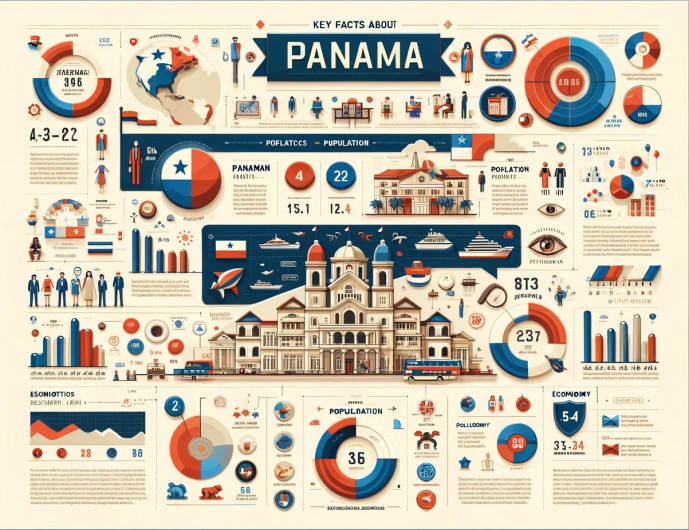Key Facts of Panama: Demogragphy, Population, Economy, Politics, etc…
Explore Panama's vibrant culture, growing economy, and dynamic political landscape.

People & Population
Population Overview
Panama is home to approximately 4.4 million people. The population density is relatively low for the region, with most inhabitants concentrated in urban areas and along the Pacific coast.
- Panama City: The capital and its sprawling metropolitan area house a significant portion of the country’s population.
- Colón: A key port city on the Caribbean entrance to the Canal.
- David: The main urban center in the western Chiriquí province.
A large percentage of the population resides within the Panama City-Colón metropolitan corridor, which serves as the country’s primary economic and logistical hub.
Ethnic & Cultural Makeup
Mestizo: This group, of mixed Amerindian and European ancestry, constitutes the largest segment of the Panamanian population, forming the backbone of the nation’s cultural identity.
Indigenous Peoples: Panama has seven major indigenous groups, including the Ngäbe, Buglé, Guna, Emberá, and Wounaan. Many of these communities live in semi-autonomous territories known as comarcas, where they preserve their unique languages and traditions.
Afro-Panamanian: This community includes two distinct groups. The Afro-Colonials are descendants of enslaved Africans brought during the Spanish colonial era, while the Afro-Antilleans are descendants of Caribbean laborers who came to build the railroad and the Canal.
Other Groups: The nation’s cosmopolitan character is enriched by vibrant European, Chinese, and other immigrant communities, each contributing to the diverse cultural and culinary landscape.
Language
The official language is Spanish, spoken with a distinct Panamanian dialect and cadence. English is widely understood in the business and tourism sectors, particularly in Panama City and Bocas del Toro. It is also the native language for many in the Afro-Antillean communities. Within the comarcas, indigenous languages remain vital to daily life.
Religion
Roman Catholicism is the primary religion, with its influence visible in festivals and architecture throughout the country. Panama also embraces religious diversity, with significant communities of Protestants, Muslims, and Jews, alongside the spiritual and ancestral beliefs practiced by indigenous groups.
Government & Politics
System of Government
The official name of the country is the Republic of Panama. It operates as a constitutional democracy and a presidential republic. The government is structured into three branches for checks and balances: the Executive (led by the President), the Legislative (the National Assembly), and the Judicial (the Supreme Court of Justice).
Political Stability
Panama generally enjoys a stable political climate and is considered one of the safest countries in Central America for travelers. The democratic government functions effectively, ensuring a secure environment for tourism and commerce.
Administrative Divisions
The country is divided into 10 provinces: Bocas del Toro, Chiriquí, Coclé, Colón, Darién, Herrera, Los Santos, Panamá, Panamá Oeste, and Veraguas. Additionally, there are six indigenous territories, known as comarcas, such as the well-known Guna Yala. These comarcas possess a degree of administrative autonomy, allowing for self-governance in accordance with their cultural traditions.
Economy & Commerce
Economic Drivers
- The Panama Canal: This engineering marvel is the cornerstone of the national economy, serving as a critical conduit for global maritime trade.
- Logistics & Trade: The Colón Free Trade Zone, located at the Caribbean entrance to the Canal, is the largest free port in the Americas and a major center for international commerce.
- Financial Services: Panama has a sophisticated and well-established international banking sector, making it a key financial hub for Latin America.
- Tourism: The tourism sector is a significant and growing part of the economy, attracting visitors for its natural biodiversity, historic sites, and modern city life.
Currency
Panama has two official currencies that function seamlessly together:
- Panamanian Balboa (PAB): The Balboa is pegged at a 1:1 ratio with the US dollar. However, it exists only in coin form, with denominations equivalent to U.S. coins.
- United States Dollar (USD): The USD is the official paper currency of Panama. All paper money in circulation is the U.S. dollar, which is used for all commercial and private transactions. Travelers carrying USD do not need to exchange currency.
Business & Tipping
General business hours are typically Monday to Friday, with shops often open on Saturdays. Banks usually operate from 8:00 AM to 3:00 PM, while retail stores may stay open until 6:00 PM or later. Tipping is customary in restaurants, where 10-15% of the bill is standard if a service charge is not already included. For tour guides and private drivers, a gratuity is not required but is always greatly appreciated for excellent service.
Geography & Key Statistics
Location & Borders
Panama is strategically located in Central America, forming a natural land bridge, or isthmus, that connects North and South America. It is bordered by Costa Rica to the west and Colombia to the east. The country enjoys extensive coastlines on the Caribbean Sea to the north and the Pacific Ocean to the south.
Time Zone
Panama operates on Eastern Standard Time (EST) year-round. It is important for travelers to note that Panama does not observe Daylight Saving Time.
Quick Stats
- Capital City: Panama City
- Total Area: Approximately 75,417 sq km (29,119 sq miles)
- Calling Code: +507
- Electricity: 120V, 60Hz. The plugs are Type A and B, the same standard used in the USA and Canada.
Could not load FAQs. Please try again later.